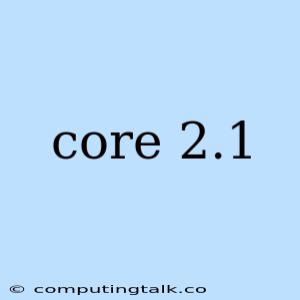Understanding Core 2.1: A Comprehensive Guide
The term "Core 2.1" can be interpreted in several ways depending on the context. It's crucial to understand the specific context to decipher its meaning. Let's explore the possibilities:
1. Core 2.1 as a Technology Version:
What is Core 2.1?
This could refer to a specific version or release of a software or hardware system. For example:
- ASP.NET Core 2.1: A popular web development framework from Microsoft, known for its flexibility and performance. This version was released in May 2018 and introduced new features like Razor Pages and SignalR.
- .NET Core 2.1: Another framework from Microsoft for building various applications. It was released in August 2018 and included improvements in performance and security.
- Linux Kernel 2.1: This refers to a specific release of the Linux kernel, the core operating system of Linux. It was released in January 1996 and brought significant advancements in device driver support and memory management.
How to Determine the Specific Core 2.1 Version:
To figure out which "Core 2.1" you're dealing with, it's essential to understand the context of its usage. Look for additional information:
- Software or Hardware Name: Is it mentioned alongside a specific product or platform?
- Documentation or Release Notes: Search for official documentation or release notes related to the product or technology.
- Online Forums or Communities: Check relevant online forums or communities for discussions related to the specific "Core 2.1" version.
2. Core 2.1 as a Hardware Specification:
Intel Core 2 Duo Processor Family:
While less common, "Core 2.1" could refer to a specific model within the Intel Core 2 Duo processor family. These processors were released between 2006 and 2011 and were known for their efficiency and performance.
Understanding the Core 2.1 Designation:
To identify the specific model, you'd need additional details like the exact CPU name, clock speed, and other specifications. For example, a "Core 2 Duo E6700" processor has a clock speed of 2.66 GHz, while a "Core 2 Duo E8400" runs at 3 GHz.
Finding Information about Core 2.1 Hardware:
You can search online for information about specific Core 2 Duo models, including performance benchmarks, compatibility details, and technical specifications.
3. Core 2.1 as a Technical Term:
Core Concepts in Computer Science:
In certain technical contexts, "Core 2.1" might not refer to a specific version or product. It could symbolize a concept within a larger system, such as:
- Core Algorithms: This refers to the fundamental algorithms or processes that form the foundation of a software or system. For instance, sorting algorithms or search algorithms are considered "core" elements in many programming languages.
- Core Data Structures: These are essential data structures like arrays, lists, or trees that are used to organize and store data in computer programs.
Determining the Meaning:
Understanding the specific context where "Core 2.1" appears is vital to determine its meaning in this scenario. Pay attention to the surrounding information, the type of document, and the technical domain discussed.
Conclusion:
The interpretation of "Core 2.1" depends on the specific context. It could be a technology version, a hardware specification, or a technical term. Always consider the surrounding information to decipher its meaning accurately.
By understanding the context and using reliable resources, you can effectively interpret the meaning of "Core 2.1" and navigate the complexities of this technical term.
